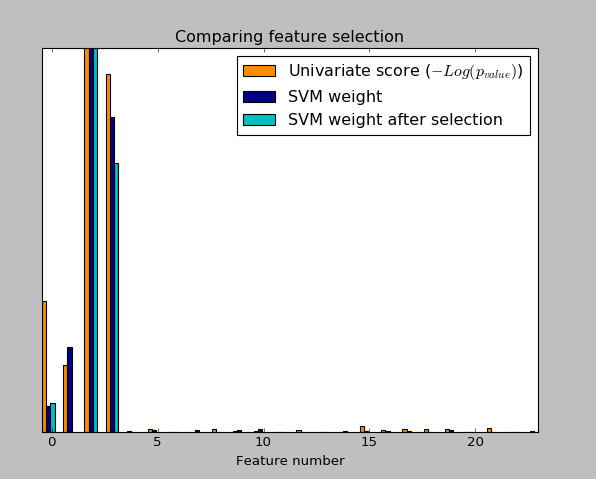单因素特征选择--Univariate Feature Selection
2016-11-24 16:57
375 查看
An example showing univariate feature selection.
Noisy (non informative) features are added to the iris data and univariate feature selection(单因素特征选择) is applied. For each feature, we plot the p-values for the univariate feature selection and the corresponding weights of an SVM. We can see that univariate feature selection selects the informative features and that these have larger SVM weights.
In the total set of features, only the 4 first ones are significant. We can see that they have the highest score with univariate feature selection. The SVM assigns a large weight to one of these features, but also Selects many of the non-informative features. Applying univariate feature selection before the SVM increases the SVM weight attributed to the significant features, and will thus improve classification.
实验结果:

Noisy (non informative) features are added to the iris data and univariate feature selection(单因素特征选择) is applied. For each feature, we plot the p-values for the univariate feature selection and the corresponding weights of an SVM. We can see that univariate feature selection selects the informative features and that these have larger SVM weights.
In the total set of features, only the 4 first ones are significant. We can see that they have the highest score with univariate feature selection. The SVM assigns a large weight to one of these features, but also Selects many of the non-informative features. Applying univariate feature selection before the SVM increases the SVM weight attributed to the significant features, and will thus improve classification.
#encoding:utf-8
import numpy as np
import matplotlib.pyplot as plt
from sklearn import datasets,svm
from sklearn.feature_selection import SelectPercentile,f_classif
###load iris dateset
iris=datasets.load_iris()
###Some Noisy data not correlated
E=np.random.uniform(0,0.1,size=(len(iris.data),20)) ###uniform distribution 150*20
X=np.hstack((iris.data,E))
y=iris.target
plt.figure(1)
plt.clf()
X_indices=np.arange(X.shape[-1]) ###X.shape=(150,24) X.shape([-1])=24
selector=SelectPercentile(f_classif,percentile=10)
selector.fit(X,y)
scores=-np.log10(selector.pvalues_)
scores/=scores.max()
plt.bar(X_indices-0.45,scores,width=0.2,label=r"Univariate score ($-Log(p_{value})$)",color='darkorange')
# plt.show()
####Compare to weight of an svm
clf=svm.SVC(kernel='linear')
clf.fit(X,y)
svm_weights=(clf.coef_**2).sum(axis=0)
svm_weights/=svm_weights.max()
plt.bar(X_indices - .25, svm_weights, width=.2, label='SVM weight',
color='navy')
clf_selected=svm.SVC(kernel='linear')
# clf_selected.fit(selector.transform((X,y)))
clf_selected.fit(selector.transform(X),y)
svm_weights_selected=(clf_selected.coef_**2).sum(axis=0)
svm_weights_selected/=svm_weights_selected.max()
plt.bar(X_indices[selector.get_support()]-.05,svm_weights_selected,width=.2,label='SVM weight after selection',color='c')
plt.title("Comparing feature selection")
plt.xlabel('Feature number')
plt.yticks(())
plt.axis('tight')
plt.legend(loc='upper right')
plt.show()实验结果:

相关文章推荐
- 单变量特征选择:Univariate feature selection
- the steps that may be taken to solve a feature selection problem:特征选择的步骤
- Weka中的Correlation based Feature Selection(特征选择)方法简介
- RELIEFF Feature Selection(RELIEFF特征选择) Python实现
- 特征选择 (feature_selection)
- mRMR特征选择算法(feature_selection)的使用
- RELIEF Feature Selection(RELIEF特征选择) Python实现
- the steps that may be taken to solve a feature selection problem:特征选择的步骤
- Feature Selection For Machine Learning in Python (Python机器学习中的特征选择)
- [置顶] 【机器学习 sklearn】特征筛选feature_selection
- 基于局部学习的特征选择:Local-Learning-Based Feature Selecti
- 特征选取1-from sklearn.feature_selection import SelectKBest
- 从sklearn.preprocessing, sklearn.feature_selection学习特征工程之预处理
- 最佳特征筛选与feature_selection
- 特征选择(feature select)
- 随机森林之特征选择
- 结合Scikit-learn介绍几种常用的特征选择方法
- 机器学习—特征选择
- neuron classification with feature selection
- 【总结】广告点击率预估中的特征选择
